 MALAYSIA--Part 1
MALAYSIA--Part 1
While Malaysia is majority Malay, it is a highly multicultural society. The Malays comprise only a bare majority, with about 55% of the population, while Chinese Malaysians make up a substantial 35% and Indian Malaysians another 10%. (These numbers refer to "Peninsular" or "Western" Malaysia, which is the area I visited, and not the areas of Sabah and Sarawak on the island of Borneo; those areas are highly diverse, with no group making up more than 20% of the population.)
What this means is that large areas of Malaysia are majority Malay, while others are more Chinese and yet others more Indian. Penang, the first place I visited in Malaysia, is one of those that is mostly Chinese. Yet, like the rest of the country, the character of Penang is defined more by how the different groups live together than by any one of them. (For this reason, I think it would make a great sister city for San Francisco!) How do Malaysian people of such different backgrounds live together in harmony? Read on and you'll find out.
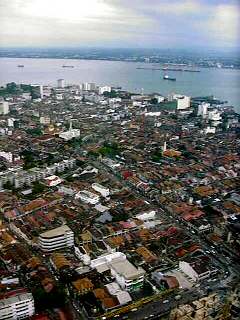
The island of Penang sits off the northwest coast of Malaysia. Strictly speaking, the city you're looking at here is called Georgetown; but, since most of the people on the island live in the city, many just call it Penang. In this photo, you can see the strait that runs between Penang and the city of Butterworth on the mainland as well as a few of the many ships that come into the port every day. You can also see that, even with the density of the houses, the city is very well-organized, with straight streets that run in a grid pattern in most places. This is a reflection of Penang's colonial history: it was the first British settlement in Malaysia, developed as a trading center by the British Empire in the late 1700's.
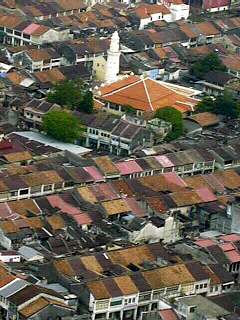 In
this closer-up view, you're looking at the center of Chinatown in Penang.
Why did Penang develop with a majority Chinese population? Penang (and Malaysia
in general) is perfectly set up along the routes where the ships pass on their
way from India to China and back; one of the country's nicknames is the "Land
Where Winds Meet." The British set the city up as a major trading center,
especially for the very profitable tea and opium trade between India and China.
Naturally, many Chinese and Indian traders came here enough that they decided
to settle down instead, and it happened that more Chinese stayed (though there
is a large Indian population here, too). As soon as you get out into the countryside
on the mainland, most of the people are Malay. So, history has a lot to do
with the way the city and its surroundings are today.
In
this closer-up view, you're looking at the center of Chinatown in Penang.
Why did Penang develop with a majority Chinese population? Penang (and Malaysia
in general) is perfectly set up along the routes where the ships pass on their
way from India to China and back; one of the country's nicknames is the "Land
Where Winds Meet." The British set the city up as a major trading center,
especially for the very profitable tea and opium trade between India and China.
Naturally, many Chinese and Indian traders came here enough that they decided
to settle down instead, and it happened that more Chinese stayed (though there
is a large Indian population here, too). As soon as you get out into the countryside
on the mainland, most of the people are Malay. So, history has a lot to do
with the way the city and its surroundings are today.
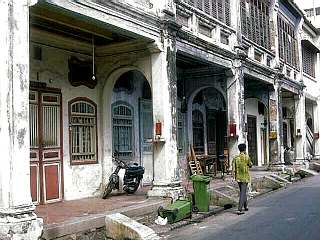 And,
when you get down onto the city streets themselves, this is what it looks
like. The buildings themselves are built in a colonial style, but their character
reflects the lives of the people who live in them. Here, each house has an
offering altar on the post outside the front, which is very characteristic
of Chinese homes in many places.
And,
when you get down onto the city streets themselves, this is what it looks
like. The buildings themselves are built in a colonial style, but their character
reflects the lives of the people who live in them. Here, each house has an
offering altar on the post outside the front, which is very characteristic
of Chinese homes in many places.
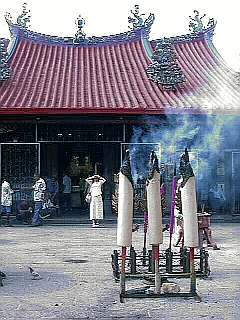 Farther
down any street, you're almost certain to run into a Chinese temple like this,
busy with people making offerings and praying. (I think these are the largest
joss sticks I've ever seen; they were being sold at a stand near the temple
for 100 Malaysian Ringgit each, which is about three dollars U.S.)
Unlike in Thailand, where the form of Buddhism practiced is called Theravada,
the Chinese practice Mahayana Buddhism, which has stricter rules
regarding ritual and practice. The temple is a central place for such things
to take place. As in China, most Chinese people's beliefs are not simply Buddhist,
though, but instead are mixed with Taoist philosophy, Confucianism and ancestor
worship.
Farther
down any street, you're almost certain to run into a Chinese temple like this,
busy with people making offerings and praying. (I think these are the largest
joss sticks I've ever seen; they were being sold at a stand near the temple
for 100 Malaysian Ringgit each, which is about three dollars U.S.)
Unlike in Thailand, where the form of Buddhism practiced is called Theravada,
the Chinese practice Mahayana Buddhism, which has stricter rules
regarding ritual and practice. The temple is a central place for such things
to take place. As in China, most Chinese people's beliefs are not simply Buddhist,
though, but instead are mixed with Taoist philosophy, Confucianism and ancestor
worship.
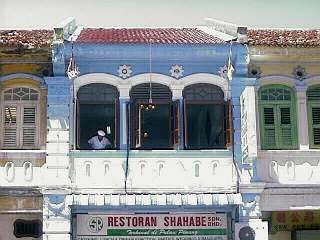 Not
everything in Penang is Chinese, though. In this photo, you see more Indian
influence, both in the decoration on the fronts of the houses and the dress
of the man looking out the front. Most Indians in Malaysia practice Hinduism,
but many are Muslim.
Not
everything in Penang is Chinese, though. In this photo, you see more Indian
influence, both in the decoration on the fronts of the houses and the dress
of the man looking out the front. Most Indians in Malaysia practice Hinduism,
but many are Muslim.
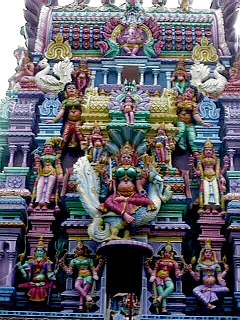 In
this area of town called Little India, I found a very important temple called
Sri Mariamman temple. This roof is carved in a style for Hindu temples commonly
found in southern India, and obviously brought to Penang by traders from there.
(It may seem like it's far away, but look on a map: India is right across
the Andaman Sea from Malaysia!) From what you've seen so far, you may think
that people's of different backgrounds all live separately from one another,
in Little India or Chinatown or other neighborhoods; but the fact is, you
see all different kinds of people living and doing their daily business in
each area. The more distinct-seeming areas, like Little India and China, arose
when people first came to Penang and set up their businesses here, but over
the long period since then people have mixed throughout the city.
In
this area of town called Little India, I found a very important temple called
Sri Mariamman temple. This roof is carved in a style for Hindu temples commonly
found in southern India, and obviously brought to Penang by traders from there.
(It may seem like it's far away, but look on a map: India is right across
the Andaman Sea from Malaysia!) From what you've seen so far, you may think
that people's of different backgrounds all live separately from one another,
in Little India or Chinatown or other neighborhoods; but the fact is, you
see all different kinds of people living and doing their daily business in
each area. The more distinct-seeming areas, like Little India and China, arose
when people first came to Penang and set up their businesses here, but over
the long period since then people have mixed throughout the city.
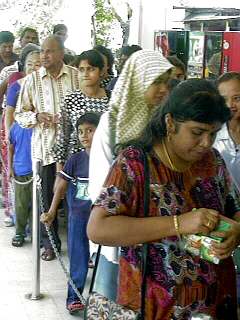 Here's
an example of that diversity, in a line waiting to go up the "Funicular Railway"
to the top of Penang Hill. You can see here people from a variety of backgrounds.
(I don't have a photo of the railway, unfortunately, but I assure you it's
amazing; you sit in a box and go up the hill at about a forty-five degree
angle for a half an hour. It feels like you're going straight up!)
Here's
an example of that diversity, in a line waiting to go up the "Funicular Railway"
to the top of Penang Hill. You can see here people from a variety of backgrounds.
(I don't have a photo of the railway, unfortunately, but I assure you it's
amazing; you sit in a box and go up the hill at about a forty-five degree
angle for a half an hour. It feels like you're going straight up!)
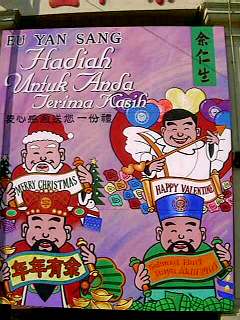 And
here's yet another example of the tolerance for diversity you see all around
Malaysia: a sign wishing people happy holidays, for four different holidays.
There aren't many Christians in Peninsular Malaysia (though there are many
among the tribal peoples of Eastern Malaysia, due to the influence of missionaries),
yet the sign wishes EVERYONE a Merry Christmas! Indeed, Malaysians love to
celebrate holidays, and holidays of many different varieties are official
nationally. The government guarantees freedom of religion, too, and the people
of the country certainly act on it.
And
here's yet another example of the tolerance for diversity you see all around
Malaysia: a sign wishing people happy holidays, for four different holidays.
There aren't many Christians in Peninsular Malaysia (though there are many
among the tribal peoples of Eastern Malaysia, due to the influence of missionaries),
yet the sign wishes EVERYONE a Merry Christmas! Indeed, Malaysians love to
celebrate holidays, and holidays of many different varieties are official
nationally. The government guarantees freedom of religion, too, and the people
of the country certainly act on it.
My second day in Pe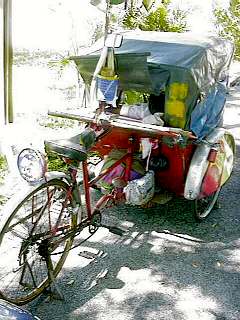 nang,
I decided to take a becak (three-wheeled bicycle taxi) around the city.
I passed by this one, and woke up the driver to get going. After haggling
our way to an acceptable price, we were on our way. Here is a description
I read that I think perfectly captures the sounds and sights I encountered:
"...in the early morning...the entire street becomes a market. Trishaws (becaks)
mass at the entrance awaiting housewives laden with their day's shopping.
Stalls are not in any order, it is more like organized chaos. A butcher hacks
up pork beside a mango seller, whose sales patter is drowned out by a neighboring
stall which advertises "Buddha Cassettes Sold Here." Piles of fresh greens
are stacked beside brooms and brushes. The rasp of a sugar-cane crusher making
juice, competes with the sizzle of bean shoots fried with noodles, and the
haggling of old women as they sort out sea slugs and barter over salted eggs."
(From "Periplus Travel
Guide: West Malaysia and Singapore, ed. by Wendy Moore, Periplus Editions,
1993)
nang,
I decided to take a becak (three-wheeled bicycle taxi) around the city.
I passed by this one, and woke up the driver to get going. After haggling
our way to an acceptable price, we were on our way. Here is a description
I read that I think perfectly captures the sounds and sights I encountered:
"...in the early morning...the entire street becomes a market. Trishaws (becaks)
mass at the entrance awaiting housewives laden with their day's shopping.
Stalls are not in any order, it is more like organized chaos. A butcher hacks
up pork beside a mango seller, whose sales patter is drowned out by a neighboring
stall which advertises "Buddha Cassettes Sold Here." Piles of fresh greens
are stacked beside brooms and brushes. The rasp of a sugar-cane crusher making
juice, competes with the sizzle of bean shoots fried with noodles, and the
haggling of old women as they sort out sea slugs and barter over salted eggs."
(From "Periplus Travel
Guide: West Malaysia and Singapore, ed. by Wendy Moore, Periplus Editions,
1993)
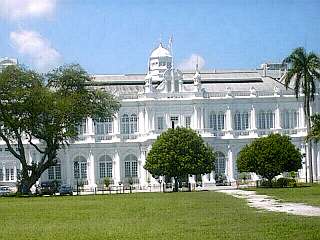 In
a certain area of the city we passed remnants of the city's colonial past.
This is City Hall, which was built by the British about one hundred years
ago and is used by the Malaysians as their own city hall today. One of the
themes of modern Malaysia is how they're dealing with overcoming the problems
coming from having been colonized; one solution, as here, is to use those
things that were left over and to build a new society on top of them.
In
a certain area of the city we passed remnants of the city's colonial past.
This is City Hall, which was built by the British about one hundred years
ago and is used by the Malaysians as their own city hall today. One of the
themes of modern Malaysia is how they're dealing with overcoming the problems
coming from having been colonized; one solution, as here, is to use those
things that were left over and to build a new society on top of them.